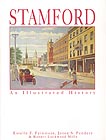 Estelle F. Feinstein, Joyce S. Pendery,
Estelle F. Feinstein, Joyce S. Pendery,
Robert Lockwood Mills,
Don Russell (Introduction
Stamford: An Illustrated History
Revised Edition July 2002
Hardcover, 219 pages
$23.95 |
Historian takes a new look at Stamford's
past
By David Podgurski
Staff Writer
The Advocate
September 1, 2002
The history
of Stamford has been a history of change, but also a tale of how some things
remained
unaltered in “the city that
works.”
The winding
road of its intricate timeline are traced in the recently revised “Stamford: An Illustrated History.” Originally
published in 1984 and written by Estelle F. Feinstein and Joyce S. Pendery,
the history has been revised by Robert Lockwood Mills, who edited the book's
first nine chapters and wrote its final three.
Mills, a longtime New Canaan resident who lives in
Meriden, says Stamford's strength has been weathering economic turmoil and social
upheaval while retaining its sociable charm.
“Economically, it's a city, socially it's a
town,” Mills says. “Its ability to manage change is what sets it apart.
When other cities lost their primary industries, they didn't recover. When
Stamford lost the lock business (in the 1950s), it changed. Also it's due to
its work
force -- highly educated, especially educated women; think of all those shoppers
to fill the mall. Educated women -- now they are part of the Information Age
work force.”
Stamford was
once known as “The Lock City” because of the massive Yale & Towne Manufacturing Co. in the South End.
When the plant moved in the '50s, Stamford became “The Research City” as research laboratories and high-tech companies started up. Today, Stamford
is more akin to “The Corporate City,” with Fairfield County third
behind New York and Chicago in number of Fortune 500 companies.
“Urban development generally -- the movement
of Fortune 500 companies in -- the reverse commuting phenomenon, that's something
they don't have in Danbury,” Mills says. “If you live in New York,
you can commute to Stamford. The proximity is still there.”
This proximity
and influx of corporate giants was something foreseen by a 1929 report written
by Herbert
Swan. Titled “Plan
of a Metropolitan Suburb,” Swan's report urged Stamford to acquire land
for additional parks and recreational areas and to construct a vigorous network
of highways along with zoning regulations. The plan was shelved during the
Great
Depression, but the natural course of history proved Swan's foresight.
“Eventually, the city fathers managed to incorporate
into the renewal of the city some socially progressive moves that were a little
avant-garde -- busing, target schools. Swan also must have foreseen I-95, but
the infrastructure in 1928 could not have held it,” Mills says.
The book charts
the history of Stamford through the Depression and urban renewal to its status
as part
of Connecticut's “Gold
Coast.” From its early beginnings as “Rippowam” in the 1600s,
Stamford had been vital as a site along Native American trade routes to and
from Manhattan.
Few at that time could have predicted the sprawling
city of more than 110,000 that Stamford would become. One of the more intriguing
aspects of the city's history has been its ethnic diversity -- not without its
share of conflict -- as a point of convergence for immigrants.
“Stamford is interesting,” Mills says.
“It is a suburb, but it has always had a more New York mindset than a Darien
or New Canaan mindset. It's like an oasis for minorities, socially speaking.
. . . It's a socially aware, socially progressive town and I was surprised
to
learn how much had been done to help the minorities along on a social basis.
Stamford, through its churches and its local black leaders, was very active
in helping minorities.”
And where is Stamford going, according to Mills?
“I don't embrace the Information Age entirely,
but I think the Information Age is here to stay,” he says. “I would
imagine media, financial services -- media that will become more electronic,
not less -- that office space will fill with financial services, communications.
The American economy is still filled with geniuses and they never stop being
geniuses and they will find Stamford -- Stamford won't have to go looking for
them.”
During the editing
process, Mills found that he is a descendant of a man mentioned early in “Stamford An Illustrated History,” one
Isaac Lockwood.
-- “Stamford: An Illustrated History” is
published by the American Historical Press and retails for $32.95.
Copyright © 2002,
Southern Connecticut Newspapers, Inc.
Reprinted
with permission.
Note: The
book contains an enlarged biliography as compared to the old one. Many of the
B & W images are from
the Sociey's own photo collection. IBH
Books in our Library

